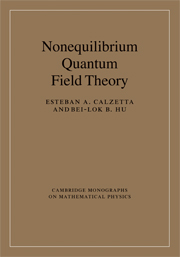Book contents
- Frontmatter
- Contents
- Preface
- I FUNDAMENTALS OF NONEQUILIBRIUM STATISTICAL MECHANICS
- II BASICS OF NONEQUILIBRIUM QUANTUM FIELD THEORY
- 4 Quantum fields on time-dependent backgrounds: Particle creation
- 5 Open systems of interacting quantum fields
- 6 Functional methods in nonequilibrium QFT
- III GAUGE INVARIANCE, DISSIPATION, ENTROPY, NOISE AND DECOHERENCE
- IV THERMAL, KINETIC AND HYDRODYNAMIC REGIMES
- V APPLICATIONS TO SELECTED CURRENT RESEARCH
- References
- Index
6 - Functional methods in nonequilibrium QFT
from II - BASICS OF NONEQUILIBRIUM QUANTUM FIELD THEORY
- Frontmatter
- Contents
- Preface
- I FUNDAMENTALS OF NONEQUILIBRIUM STATISTICAL MECHANICS
- II BASICS OF NONEQUILIBRIUM QUANTUM FIELD THEORY
- 4 Quantum fields on time-dependent backgrounds: Particle creation
- 5 Open systems of interacting quantum fields
- 6 Functional methods in nonequilibrium QFT
- III GAUGE INVARIANCE, DISSIPATION, ENTROPY, NOISE AND DECOHERENCE
- IV THERMAL, KINETIC AND HYDRODYNAMIC REGIMES
- V APPLICATIONS TO SELECTED CURRENT RESEARCH
- References
- Index
Summary
One of the major goals in the establishment of a quantum field theory for nonequilibrium systems is to study dynamical problems, following the evolution of the expectation value of a physical variable with respect to an in state. This is different from a scattering problem characterized by the transition amplitude between the in and out states, as is treated in every textbook on quantum field theory. This problem is usually coupled with how one could identify a relevant sector of the theory as the system (light fields vs. heavy fields, slow modes vs. fast modes, long wavelength modes vs. short ones, etc.) and determine the effect of its other sectors as the environment on this system, as we have discussed in the last chapter.
Given a classical nonequilibrium system, described, for example, by a Langevin equation, there are essentially three possible strategies to follow. One may attempt to solve it, usually numerically. In the quantum field case, this gets difficult beyond the linear case. Second, one may try to transform it into an equation for the evolution of a probability distribution function in the system's configuration space. In the quantum field case the relevant object is the reduced density matrix, and the relevant equation is the Liouville-von Neumann equation. This is also infeasible beyond the linear case, unless under restrictive approximations (such as Gaussianity) which in fact reduce this approach to the third and coarsest.
- Type
- Chapter
- Information
- Nonequilibrium Quantum Field Theory , pp. 170 - 208Publisher: Cambridge University PressPrint publication year: 2008
- 1
- Cited by

